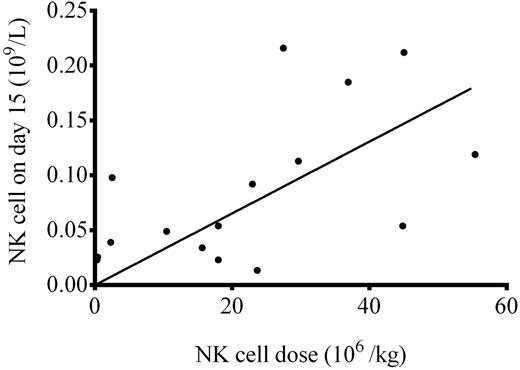Abstract
Introduction
Autologous hematopoietic stem cell transplantation (aHSCT) is still considered standard of care for eligible myeloma patients following induction treatment. Beside the effect of a high dose melphalan, several studies proposed a beneficial effect of immune graft versus myeloma effect following aHSCT. The higher number of lymphocytes and natural killer (NK) cells on day 15 after aHSCT correlated with a better longterm outcome. We have previously published the data on the influence of different mobilization regimens on the number of collected lymphocytes and NK cells and their number on day 15 post aHSCT. In this abstract we present the data on the correlation between the dose of reinfused lymphocytes, NK cells and CD34+ cells and the number of lymphocytes and NK cells on day 15 after aHSCT.
Methods
We prospectively enrolled 48 newly diagnosed myeloma patients following induction treatment with bortezomib and dexamethasone. They were mobilized with either filgrastim (10 mcg/kg body weight daily), pegfilgrastim (12 mg one-time injection) or cyclophosphamide (4 g/m2) followed by filgrastim (10 mcg/kg body weight daily).
The lymphocyte and NK cell (CD16+/56+) counts in the stem cell concentrate and on day 15 post aHSCT in peripheral blood were determined with the flow cytometer. Pearson r correlation was used to associate the dose of infused cells and their number on day 15 after aHSCT in peripheral blood. Scatter plots and linear regression were used for the data presentation. SPSS Statistics v21 (IBM, USA) was used for the analysis. The study complied with the Declaration of Helsinki and was approved by the local ethical committee. All patients signed a written informed consent.
Results
We established a correlation between the dose of infused lymphocytes in the autologous graft and their number in the peripheral blood on day 15 after aHSCT (Figure 1; Pearson r = 0.27, p = 0.04). There was also a correlation between the dose of infused NK cells and their number in the peripheral blood on day 15 post aHSCT (Figure 2; Pearson r = 0.6, p < 0.01). However, there was no correlation between the number of reinfused CD34+ cells and the number of lymphocytes on day 15 after aHSCT (Figure 3).
Conclusion
The early immune repopulation is important for better overall survival after the aHSCT in multiple myeloma and lymphoma patients. The data from our study showed that the higher numbers of reinfused lymphocytes and NK cells, but not the total number of CD 34+ cells, significantly impact earlier lymphocyte and NK cell engraftment. We concluded that with the aim to achieve the best possible outcomes of aHSCT for our patients, we must make sure to reinfuse not only sufficient number of CD 34+ cells, but also of lymphocytes and NK cells.
Correlation between a dose of the infused lymphocytes and their number in the peripheral blood on day 15 after aHSCT (Pearson r = 0.27, p = 0.04).
Correlation between a dose of the infused lymphocytes and their number in the peripheral blood on day 15 after aHSCT (Pearson r = 0.27, p = 0.04).
Correlation between the dose of the infused NK cells and their number in the peripheral blood on day 15 post aHSCT (Pearson r = 0.6, p < 0.01).
Correlation between the dose of the infused NK cells and their number in the peripheral blood on day 15 post aHSCT (Pearson r = 0.6, p < 0.01).
Correlation between the dose of infused CD34+ cells and the total lymphocyte number in the peripheral blood on day 15 post aHSCT.
Correlation between the dose of infused CD34+ cells and the total lymphocyte number in the peripheral blood on day 15 post aHSCT.
Skopec:amgen: Consultancy, Honoraria; novartis: Honoraria.
Author notes
Asterisk with author names denotes non-ASH members.




This feature is available to Subscribers Only
Sign In or Create an Account Close Modal